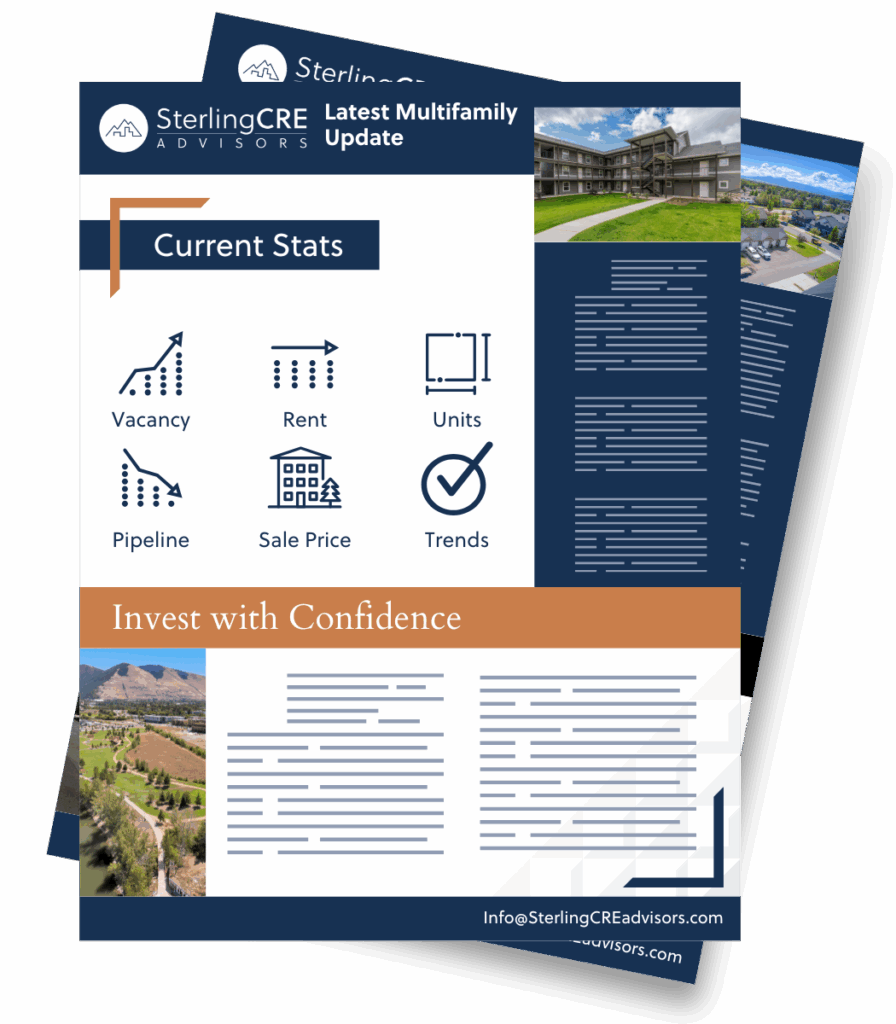Commercial real estate professionals have access to a lot of data. A piece of data like a vacancy rate or a closing price can be helpful. It’s a nugget of information that can be used to create a bigger picture.
Our goal at SterlingCRE is to help our clients make well-informed decisions. Our research team collects market data and analyzes that data on a daily basis in order to help our clients make the best real estate decision(s) possible.
Key Commercial Real Estate Data Types
Market Data
Market data is information like vacancy rates and sales prices. On a basic level, these indicate how much supply is available and what people are paying for spaces. A low vacancy rate of 1% or 2% would indicate an extremely low inventory of available space, and because of this landlord’s/seller’s pricing expectations are going to be fairly aggressive and will most likely continue to rise until the vacancy is increased or at least stabilized.
Development Pipeline
In markets with active development like Bozeman and Missoula, understanding the pipeline is a crucial part of forecasting future market conditions. The development pipeline tracks the amount of commercial real estate under construction or being planned in the market.
Demand Drivers
Demand drivers are the people and entities that use commercial real estate. For example, demand drivers for multifamily apartments are activities that cause population growth. This could be new jobs, a surge in retirees, or an increase in student enrollment at a university. Most communities have regularly updated population and employment projections to predict growth.
Projecting demand can be tricky. For example, while Missoula and Bozeman had enjoyed steady growth for years, the boom caused by the rapid growth in remote workers due to COVID could not have been predicted.
Creating the Big Picture- A Case Study
Looking at each data category creates one part of the picture. To get the whole picture and accurately forecast the outlook for a commercial real estate asset requires bringing the data together.
In August 2022, the market data for multifamily showed a severe lack of supply. For multiple quarters, the vacancy rate failed to rise above 2%. Rent growth was consistent at over 13% for the year. Waitlists were common. Just looking at the market data painted a picture that Bozeman would be a landlord’s market in 2023.
At the time, the development pipeline showed over 1200 units under construction. This would have a significant impact on Bozeman’s apartment inventory. While pent-up demand would absorb many of these apartments, the amount coming on the market exceeded the expected demand considerably.
Back in 2022, the SterlingCRE team predicted that Bozeman’s multifamily vacancy rate would rise through 2023 into 2024 based on this pipeline. As of June 2023, Bozeman’s multifamily vacancy rate is at 6.92%. Landlords have had to transition from maintaining waiting lists to offering incentives in 12 months.
Such a dramatic shift can be cause for heartburn. However, a look at demand drivers shows that Bozeman is continuing to grow, and projections for employment growth are positive. Additionally, studies have found that households are renting longer, meaning that more apartments are needed.
So while Bozeman may have high multifamily vacancy rates for a few years, they should drift back to a more balanced level as new residents continue to move to the city.
Closing the Circle
Investors who only looked at a short time frame of market data in their decision-making process may have made some costly errors in underwriting. Those who took a more comprehensive look at Bozeman’s multifamily market likely had more conservative underwriting and should withstand a short-term market shift.
Bozeman’s commercial real estate market is coming off a short-term market shift. Limited supply met with strong demand, pushing values for some assets well above sustainable levels. As new supply meets more consistent demand, vacancy is likely to rise across asset types and begin to push values down, correcting the market’s course.
It is important to keep in mind that the long-term outlook for Bozeman is positive. Bozeman offers a high quality of life, an educated workforce, and a business-friendly environment. A balanced real estate market where supply meets demand is key in supporting a thriving community.
Our talented team of advisors will be presenting current data and analysis for the Bozeman market on September 7th. Please join us at Bozeman MarketWatch to learn more about the outlook for Bozeman’s commercial real estate market into 2024 and beyond. A link to sign up to attend is below.

